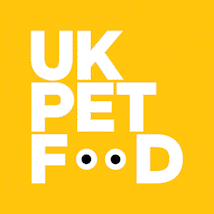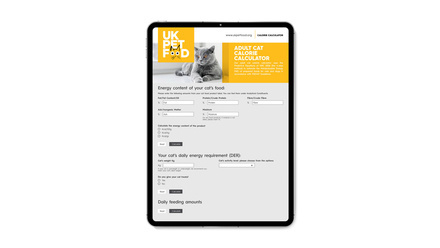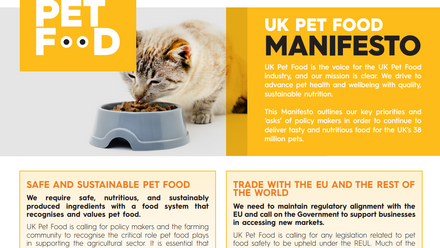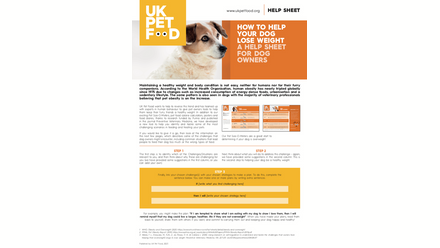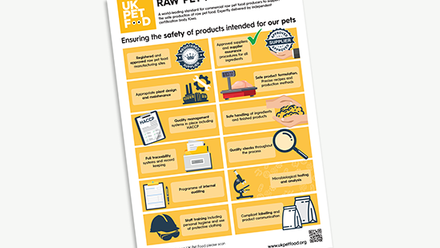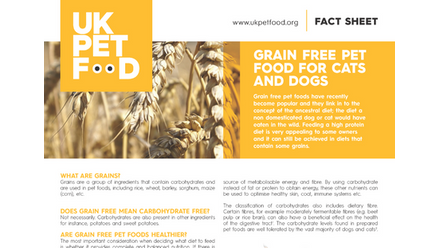Animal Proteins in Pet Food
Are animal proteins used in pet food? Learn about what animal-based ingredients are used in pet food with our fact sheet.
There are strict rules governing the ingredients that can be used in pet food to ensure safe and nutritious products. The pet food industry uses surplus products from the human food chain, all of which must come from animals that have been slaughtered under veterinary supervision, and meet the very high standards set in EU legislation.
Ensuring the Right Nutrition
Members of UK Pet Food manufacture their diets in line with the FEDIAF (European Pet Food Federation) Nutritional Guidelines for Cats and Dogs. These guidelines detail the nutritional needs of cats and dogs at varying life stages – growth, adult and senior. The guidelines are peer-reviewed by independent European veterinary nutritionists and are regularly updated with the latest science.
These foods are designed to be only a part of the diet and do not meet the known nutritional requirements when fed alone. They must be fed along with an additional food such as mixer biscuits. Complementary foods are often referred to as treats and can be fed to your pet in moderation.
These pet foods are nutritionally complete, providing all the nutrients in the amounts and proportions your pet needs. Only complete pet foods are suitable for daily feeding without adding further food products.
What animal-based ingredients are used in pet food?
Many different parts of the animal are used in pet food. These are often parts that might not sound appealing to the UK consumer but are enjoyed by our pets. For instance – liver, tripe, pig’s trotters, udders and chicken feet are commonly used in pet food. These ingredients provide an excellent source of protein, essential amino acids and other valuable nutrients. The priority of the pet food manufacturer is to source nutritionally valuable ingredients to produce high-quality and nutritionally balanced pet food.
Other sources of protein in pet food
• Fish
• Dairy products and eggs
• Vegetables and legumes such as potatoes and soybeans
• Cereals (as well as providing a good source of energy, cereals can provide a proportion of the protein)
Animal-based ingredients NOT permitted in pet food
• Any ingredients from an animal that has NOT passed vet inspections as fit for human consumption at the time of slaughter
• Waste products, road kill, diseased meat etc.
Animal-based Ingredients in Pet Food FAQs
You may have seen the term ‘meat and animal derivatives’ on pet food labels, this simply refers to the animal based ingredients in the recipe and is a term prescribed in law. Most pet foods are made from a recipe using several ingredients which are all combined into a food to meet, in part or entirely, the daily nutritional requirements of the pet. They can be listed on the pet food label under a category description such as ‘meat and animal derivatives’ or as a full ingredients list.
Not at all. It doesn’t matter if you use the term ‘meat and animal derivatives’ or list all the animal derived ingredients separately (chicken meal, beef, liver etc) because all the ingredients are subject to the same strict rules for quality and safety, and all recipes are carefully formulated to ensure they meet the pets’ nutritional needs in line with the FEDIAF Nutritional Guidelines.
Category descriptions are groups of similar ingredients that can be declared together instead of individually. The name of the category and definition of what materials it covers are set by the legislators in Brussels. Listing ingredients by category means some producers can select ingredients based on available supply, for instance an increase in turkey at Christmas time, without changing labels constantly which helps keep prices consistent. Shorter ingredients lists on small packet sizes also leaves more space for other useful information. Along with ‘meat and animal derivatives’, common categories include ‘oils & fats’, ‘vegetables’ and ‘minerals’. There are also many pet foods which have a full ingredients list on the label so there is plenty of choice for pet owners.
As is the case for all ‘fresh’ ingredients used in pet food these must not have been subject to any treatment except chilling. Fresh ingredients cannot have been dried, frozen, cured or previously cooked prior to being made into a pet food. Is fresh meat used in dry pet foods? In dry pet foods the animal protein used can either be dry (usually called meal) or fresh – both are good-quality protein sources.
Meals are animal by-products that have been heat treated and dried with most of the moisture and the fat removed. As a result, it provides a concentrated protein source.
As mentioned, each pet food recipe includes a blend of different ingredients to meet the daily nutritional requirements of the pet. Manufacturers can also choose to present different varieties for the pet – for example, with chicken or with duck. If they do this, they are drawing attention to the presence of the named ingredient in the product, and are legally required to indicate how much is present in the recipe. The percentage stated is the minimum percentage content of the named ingredient, that is guaranteed to be present. Other nutritious meat and animal derivatives can also be present and the total percentage of meat and animal derivatives on the pack is very likely to be higher.
Useful Resources
There are differences between pet food legislation in Europe (including the UK) and the US. If looking online, it’s important to check that the source of information is relevant to the country where you are based.
